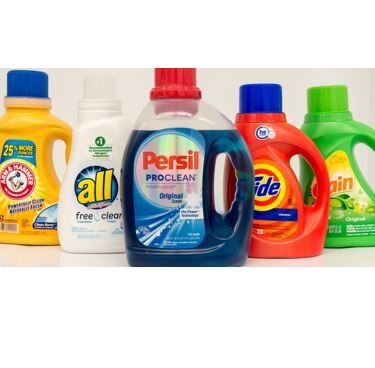[Originally posted Feb 17, 2005]
My eighth grade homeschooled daughter Julie just completed a very successful science fair project. Her report has been documented here for the benefit of all consumers. Perhaps this will launch her into a lucrative advertising contract with Tide!
Do you ever wonder while buying laundry detergent, do you actually get what you pay for? My hypothesis is that the higher the price of the laundry detergent, the better it cleans. In order to show this, I am going to experiment with different laundry detergents to see which cleans the best. If my hypothesis is correct, then Tide will clean the best, because it is the most expensive.
According to Bob Gilbreath, who works for Tide, “Tide is one of the most popular consumer brands of laundry detergent in the world.” In this paper, I will be discussing my preparation for this experiment, the conducting of the actual experiment, and the results of the experiment.
In order to prepare for my experiment, there were various steps involved. Because I was going to test ten different stains with each detergent, I organized individual pieces of 100% cotton fabric with ten circles on each piece of cloth. Purposefully, I decided to stain each cloth on the same day, because I wanted the stains to have set for the same amount of time. I also labeled the pieces of fabric A-J. The stains I chose to use were dirt, grass, ink, grape juice, BBQ sauce, oil and grease, liquid strawberry jello, blood (from meat), peach juice, and tomato sauce. Measuring 1/4 teaspoon of the liquid stains onto the pieces of cloth, I was careful to use the same amount for each stain. When I was finally done staining the cloth, I selected my eight different detergents.
The cost for each detergent was the Wal-mart price per ounce of small liquid containers. The detergents and their price per ounce were as follows: Tide (6 cents), Wisk (4.8 cents), Gain (4.8 cents), Ultra (3.9 cents), All (3.8 cents), Fab (3 cents), Purex (2.8 cents), and Sun (2 cents). I also chose to use water as my control to see whether the use of detergent even made a difference. After one week of letting the stains set, I decided it was finally time to wash the sheets of fabric.
Because the evaluation of the effectiveness of each detergent was going to be determined by examination, it was important that it be a blind study so that the evaluations would not be biased. In order to accomplish this, I numbered nine paper bags. Then, I had my father randomly put a cloth in each bag, recording which bag number corresponded to which cloth letter. As I washed the pieces of cloth, I was careful not to notice which cloth letter was being washed by which detergent. Instead, I made a different key matching bag numbers and detergents. After I was finished, I would be able to put those keys together to figure out which cloth letter was washed in which detergent.
Individually, each cloth went through the washing machine filled with a 1/2 cup of a different laundry detergent. I wanted them each to be washed with the same amount of laundry detergent, because we were measuring the price by ounces. After the washing cycle was over, I hung the sheets or fabric up to dry, not looking at the letter of the cloth. After drying overnight, the fabric swatches were ready to be examined. Because of my efforts to keep it a blind study, I had no idea which detergent had been used on which cloth.
Evaluating the pieces of cloth was a challenging job. Each individual circle was given a 1-5 rating according to the following guidelines:
1 – stain unchanged
2 – stain slightly gone
3 – stain half gone
4 – stain mostly gone
5 – stain completely gone
Each type of stain was evaluated simultaneously for all nine cloths. For example, all dirt stains were rated first. Next, the grass stains were evaluated. This procedure was followed for all ten stains.
My mom and I discussed every individual circle and agreed upon an appropriate rating. Care was taken to ensure that similar outcomes were given identical ratings. After all ten stains on every cloth had been evaluated, each cloth was given a final score, calculated by summing up the scores for each of its stains.
Surprisingly, few of the detergents could take out the grass, dirt, or ink stains. I lined the bottles of detergent up by price from highest to lowest, and then my dad read off the score of each laundry detergent. I made switches where necessary, but the results were very consistent with the prices. Although the maximum score could have been fifty points for a perfectly spotless cloth, the highest score from my experiment was 38 points. The lowest score, 27, represented washing without detergent. This was only one point worse than washing with the cheapest brand of detergent, Sun. The ratings were all within a ten point range of each other.
The following are the brands listed in order of their cleaning performance from best to worst:
-
Tide (6.0 cents/ounce),
-
Gain (4.8 cents/ounce),
-
Ultra (3.9 cents/ounce),
-
Wisk (4.8 cents/ounce),
-
Purex (2.8 cents/ounce),
-
All (3.8 cents/ounce),
-
Fab (3.0 cents/ounce),
-
Sun (2.0 cents/ounce),
-
and water (0.0 cents/ounce).
The results supported my hypothesis that, generally speaking, the higher the price of the laundry detergent, the better it cleans. If one is looking for a highly-effective cleaner, Gain is the best buy. It cleans just as well as Tide, and is 20% less costly.
However, the cleaner with the median score, Purex, represents an excellent value, because it is less expensive than all but one of the detergents. Next time, while you are shopping for laundry detergent, remember that the price of laundry detergent is frequently correlated to its cleaning ability.

